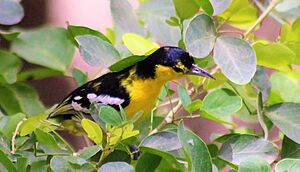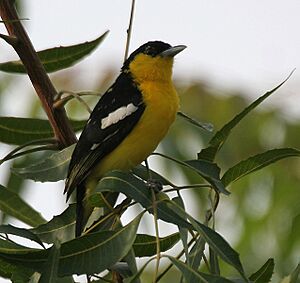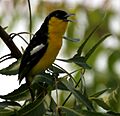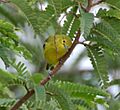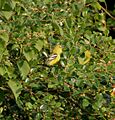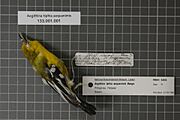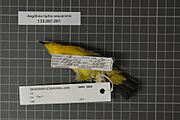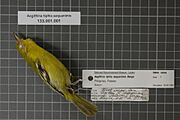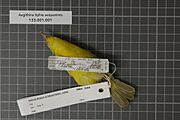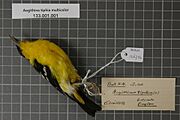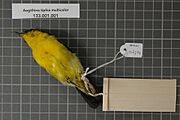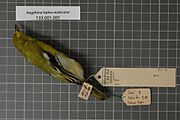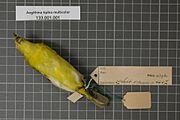Common iora facts for kids
Quick facts for kids Common iora |
|
|---|---|
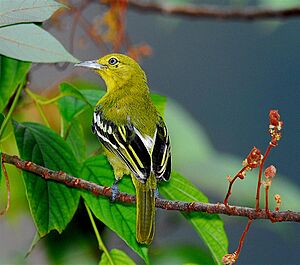 |
|
| Common iora |
|
| Conservation status | |
| Scientific classification | |
| Genus: |
Aegithina
|
| Species: |
tiphia
|
| Synonyms | |
|
Motacilla tiphia Linnaeus, 1758 |
|
The common iora (Aegithina tiphia) is a small, colorful bird. You can find these birds in warm, tropical parts of Asia. This includes places like India and Southeast Asia.
Ioras live in scrublands and forests. They are easy to spot because of their bright colors. You can also hear them from their loud whistles. During the breeding season, male ioras do a special dance. They fluff up their feathers and fly in spirals. They look like a colorful ball of green, black, yellow, and white!
Contents
Different Types of Ioras
Scientists have found that common ioras have different looks. These different groups are called subspecies. There are eleven recognized subspecies of the common iora. They are found in various regions across Asia.
- A. t. multicolor – found in southwest India and Sri Lanka
- A. t. deignani – found in south and east India, and north and central Myanmar
- A. t. humei – found in central India
- A. t. tiphia – found from north India to west Myanmar
- A. t. septentrionalis – found in the northwest Himalayas
- A. t. philipi – found in south-central China, east Myanmar, north Thailand, and north and central Indochina
- A. t. cambodiana – found in southeast Thailand, Cambodia, and south Vietnam
- A. t. horizoptera – found in southeast Myanmar, southwest Thailand, the Malay Peninsula, Sumatra, and nearby islands
- A. t. scapularis – found in Java and Bali
- A. t. viridis – found in central and south Borneo
- A. t. aequanimis – found in north Borneo and the west Philippines
What Do Common Ioras Look Like?
Ioras have a pointed beak. Male and female ioras look different, especially during breeding season. This is called being sexually dimorphic.
Male ioras have a black cap and back when they are breeding. Their wings and tail are black all year. Females have greenish wings and an olive-colored tail. Both males and females have yellow undersides. Males also have two white bars on their wings. These bars are very noticeable during breeding season.
The amount of black on a male's back can change. For example, males in the Himalayas look more like females. They might only have a small black cap. In northwestern India, ioras are a brighter yellow. In central India, breeding males have a black cap and olive on their upper back. In southwest India and Sri Lanka, breeding males have a very black cap and back.
How Do Common Ioras Behave?
Ioras usually look for food in trees. They often search for insects among the branches. Sometimes, they join other bird species to feed together.
Iora Calls and Songs
Ioras make many different sounds. Their calls include churrs, chattering, and whistles. Their song is a trilled wheeeee-tee. They can even copy the calls of other birds, like drongos!
Building a Nest
During the breeding season, male ioras do a special courtship dance. This happens mostly after the monsoon rains. The male flies up into the air. He fluffs up all his feathers, especially the pale green ones on his rump. Then, he spirals down to his perch. Once he lands, he spreads his tail and droops his wings.
Female ioras lay two to four greenish-white eggs. They build a small, cup-shaped nest. The nest is made of grass and held together with spiderwebs. It is usually placed in the fork of a tree branch. Both the male and female bird take turns sitting on the eggs. The eggs hatch after about 14 days.
Iora Predators
Some animals like to eat iora eggs or chicks. These predators include snakes, lizards, and crows. Sometimes, another bird called the banded bay cuckoo will lay its eggs in an iora's nest. This is called brood parasitism. The cuckoo chick will then be raised by the ioras.
Ioras change their feathers twice a year. This makes it a bit tricky to tell different groups apart just by their feathers.
-
A. t. multicolor: male calling in Hyderabad, India.
-
A. t. multicolor: male calling in Shamirpet, Rangareddy district, Andhra Pradesh, India
-
Adult breeding male, Singapore
- Museum specimens for subspecies at Naturalis




